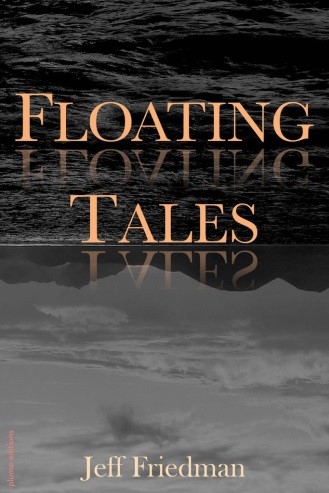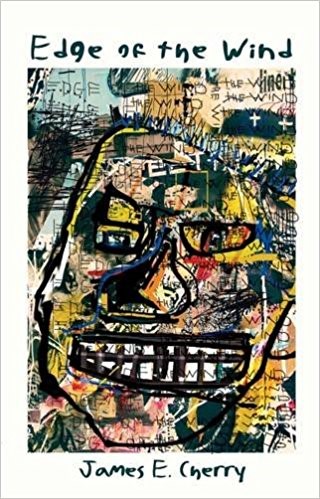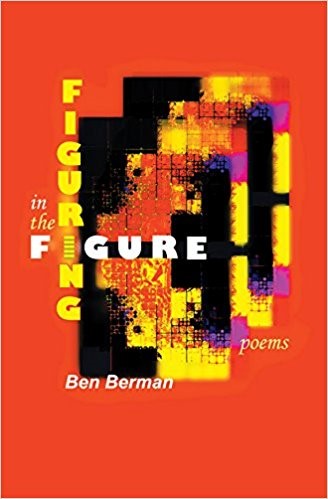Floating Tales
by Jeff Friedman
ISBN 978-1-941196-46-5
$21.95, paper.
Plume Editions, MadHat Press
Asheville NC
https://madhat-press.com/collections/plume-editions
Floating Tales
by Jeff Friedman
With an introduction by Daniel Lawless
Reviewed by William Doreski
Although the tone and mood of the prose pieces in Jeff Friedman’s new book vary from the witty to the incongruous to the zany, his subject is a serious one: the hulking presence of the absurd in ordinary lives. In his semi-fictional world bees have souls, Adam becomes the snake, someone pulls a singing clown from a hat, and a horse watches TV with a child. Friedman’s work is resolutely contemporary, but rooted in twentieth-century surrealism and Dada, To place himself in a genre context he prefaces his book with a quotation from the remarkable Russian absurdist Daniil Kharms. And all three blurbs on the back of this vivid little collection link Friedman to Russell Edson. But while he has certainly learned much from Kharms and Edson and others, Friedman has a distinctive voice that resembles no one’s, and his wit, compression, and sense of structure are often superior to those of his predecessors.
“Chair” illustrates these strengths. It begins, “When the man rises from a chair, after reading the newspaper, his body is shaped like a chair.” This compact, rhythmic sentence lays out the entire prose poem to follow. After further distortions occur, the man enters into dialogue with his wife. in a matter-of-fact way, she points out that he had already become much like a chair. Eventually she not only accepts but embraces the notion of her husband as a piece of furniture. The inevitability Friedman builds into this little vignette is amusing and convincing. The absurd is within us, and it doesn’t take much to bring it out. And in the grip of a convincing narrative structure, those around us will readily accept and normalize our irrational aspects.
Friedman’s rhetorical resources (his clever use of anaphora, for instance), his ear for dialogue, and his grasp of domestic tensions distinguish him from most contemporary writers, either of prose or verse, who attempt to depict the irrational. Further, his frequent use (or abuse) of biblical sources exposes a deep if inchoate religiosity that he wrestles into submission with self-mockery. It is self-mockery because familiar third-person figures like Adam reveal sensibilities and undergo ordeals similar to those of his first-person victims of the absurd and improbable. Not that such bizarre material is autobiographical, but rather that the psychological conditions that bring the absurd to the surface apply to all of his characters, first and third person alike, including those who seem to represent the author.
The brief narrative has become a favorite genre of our era, possibly because it fits so neatly on a website, or because attention spans have diminished. Among the many virtues Jeff Freidman’s new collection offers is a fresh opportunity to consider the difference between flash fiction (or micro-fiction, or the short-short) and prose poetry. The first two pieces in this collection tease us with a deceptively easy distinction between flash or micro fiction and the prose poem. “White Feather” is clearly a flash piece, with two characters conversing and interacting, and a carefully developed if ridiculous narrative unfolding:
The feather was long and bowed with a soft fringe. I wanted to pick it up and twirl it, but Alexsandra seemed concerned. “Did you eat a white bird?” she asked. I shook my head. “It’s only one feather,” I answered. She eyed me suspiciously, though a moment before she had seemed perfectly happy to be kissing me.
The primary action in this micro-fiction is the interplay between a man and women whose attempts at lovemaking falter because nature intrudes in the form of a dove. Although a common symbol of peace and love, the bird here is both a real creature and the embodiment of something doubtful or doubting inside the first-person protagonist. This is a brilliantly compressed short story, so we are inclined to call it flash or micro-fiction, although Baudelaire probably would have called it a poem in prose.
“Nothing,” however, seems more clearly what most people would call a prose poem. Its basic structural / rhetorical device is anaphora., the repetition of the word “Nothing” at the beginning of eight of its seventeen sentences. The word “nothing” itself occurs seventeen times. Reiteration and the development of the abstract concept of “nothing,” rather than narrative, is the guiding impetus, and we’re more likely to associate these as the intensifying and compressing devices of lyric or meditative poetry as opposed to the more expansive and expository tactics of prose.
But we can draw no clear line between the prose poem and flash fiction, and most of Friedman’s pieces do not easily fall into either category. Instead, they challenge categorization, and if they encourage us to consider the differences between prose and poetry they also discourage us from concluding that there’s any essential difference. As Daniel Lawless points out in his useful introduction, the sensibility in Friedman’s highly accomplished verse-writing extends into his prose without giving up much more than line breaks. Friedman in structuring his book makes no attempt to distinguish between (or among) genres. The five sections of Floating Tales do not arrange themselves by genre considerations but roughly by subject. While the larger issue—the persistence of the absurd—shapes the book as a whole, Friedman has arranged his work to suggest the continuity of larger overlapping narratives. Reading this book cover to cover is like reading a collection of linked short stories—very short stories—but with the intensity and urgency of good but unusually funny poetry.
About the reviewer:
William Doreski lives in Peterborough, New Hampshire, in a small house in the woods. He has published three critical studies, including Robert Lowell’s Shifting Colors. His essays, poetry, fiction, and reviews have appeared in many journals and several small-press books. His forthcoming book of poetry is The Last Concert (Salmon Poetry).
Edge of the Wind
Reviewed by Robert Cooperman
Writers of first novels often tend toward either navel gazing and veiled, or not so veiled, autobiography and the school of write what you know. Or first time novelists venture into the more exciting world of page turner thrillers. Of the two, I much prefer the page turners, rooted in plot and largely devoid of the mire of self-absorption that seems to be part of the genetic makeup of the former genre, especially when it aspires to be great literature. But now, the very fine poet James Cherry has given us his debut novel, Edge of the Wind, an excellent example of the page turner thriller, but it does double duty as a sharp depiction of its characters.
Set in and around Stovall, a fictional west Tennessee town, with its own community college, Edge of the Wind is the story of a young African American man, Alexander van der Pool, an erstwhile student at Stovall State College, then a former delivery man who could’ve moved up in the company hierarchy but for some very bad woman trouble and his unfortunately aggressive reaction to her accusations against him, and is now (or rather, has been since he was a teenager) a full-time schizophrenic who has lately chucked his meds and is about to either be sentenced to prison or sent on a return visit to a mental health institution, at the hearing he decides to skip out on. Alex also fancies himself a poet; he’s obsessed with poetry, reading it, making it, being a great poet. It’s not fame he wants, but to feel the inky blood of Shakespeare, Dickinson, Langston Hughes, Claude McKay, and all the other greats run through his veins like words on fire.
But being a schizophrenic, Alex has long, rambling talks with Tobi, who resides only in Alex’s head, and who expresses all the rage and gallows wit long associated with underclasses everywhere that Alex can’t give vent to himself and maybe doesn’t even know he’s feeling on a conscious level. Aside from being a diagnosed schizophrenic and being possessed by poetry, he’s also in possession of a gun; thus, the inevitable occurs: Alex hitchhikes to Stovall State (where he’d had a previous altercation that had ended in violence and his being expelled) and takes a literature class hostage. As much as he knows anything (on a conscious level) about the situation he’s landed himself in, all he really wants is to be able to read his poems to the class and to have them and the professor, herself a published poet, critique his efforts and to tell him he has a real future as a poet, which is itself an irony, since, as he’s later told, the number of poets who actually can make a living writing poetry can be counted on a couple of fingers on one hand.
But what Cherry gives us in the two or three samples of Alex’s poetry is the genius of almost pure gibberish, the spewings of a very disturbed mind, though Alex himself is steeped in a knowledge of the poetical canon and can quote various immortals at length. We’re presented with a kid who is dead serious, but alas, has very little talent, and part of the wonderful tension of the novel is the class’s reaction to his work: do they take it seriously or are they just humoring him, hoping to get out of there alive? Cherry never tells us directly, but we can presume it’s the latter. And indeed, it takes an excellent poet to write such purely crazed verses: think of the 18th century religious poet and madman, Christopher Smart on a cocktail of acid and meth, and you have an idea how truly deranged Alex’s poetry is, in terms of both meaning and syntax.
Aside from Alex, the Edge of the Wind abounds with other clearly and cleanly drawn characters, most notably Sheriff Warren Johnsey, who begins the novel as a good ole boy with the usual prejudices of his generation and place, and who ends up as maybe the most sympathetic character in the novel, as he tries with all his might to give poor Alex the chance the kid longs for. Cherry introduces Johnsey in full idyllic mode, on his way to his favorite stretch of the river to fish, but of course he’s thwarted by the hostage situation from having a nice, quiet day (the fish are really biting) and trying to come to grips with the memory of his dead son.
Aside from the Sheriff who is summoned to the college as hostage negotiator inundated by the news media, the hostage taker’s family and the families of the hostages, and by the merely curious who are always drawn to situations that can violently spin out of control, tries to negotiate a non-violent end to a very long and dangerous series of events, Cherry wonderfully delineates the students in and professor of the literature class who are all being held hostage. I appreciated that Cherry didn’t focus solely on Alex and Sheriff Johnsey as the major antagonists and duelists, but lets us into the lives, dreams, disillusionments, disappointments, and terrors of the class. Too often, in novels with hostage situations, the victims themselves get short shrift from the author, with all the focus spotlighting on the hyperbolically deranged and aggrieved individual calling the shots and on the stratagems of the negotiator.
But here, we’re told and shown how Megan Fly, the professor, has given up her aspirations of tenure and a big poetry career at a prestigious North Eastern university to move to rural Tennessee with her husband, who simultaneously wants to paint and to run the family farm he’s inherited. Megan is a ball of contractions: she loves her husband, but resents that he’s completely uprooted her life and her ambitions and that she’s now reduced to teaching lit to students who are taking her class because they need the credit, the easy A, and not for love of literature. Then there’s Monte Merriweather, who’s hoping he can earn a baseball scholarship to Florida State University after rehabbing a blown-out knee and starring in centerfield (like his idol Say Hey Willie Mays) for the Stovall State baseball team. There’s also Robert Strother, an out of work middle manager at a warehouse, with all his worries for his family’s suddenly precarious future and depression over what has become of his once comfortable middleclass existence. But my favorite is Brandon, the white kid who believes he’s channeling the blues of Muddy Waters, Howlin’ Wolf, and Robert Johnson, and who insists that he be called Tennessee Red (for his carrot top hair), and the odd thing is, the kid can really blow the mouth harp and play guitar. Cherry shows himself a music aficionado far beyond my feeble powers of understanding chords and notes in the way he discusses what the kid plays.
I won’t give anymore of the plot away, as I said at the outset, Edge of the Wind is a real page turner filled with humor and sorrow and a true glimpse into the human condition and what makes us all tick.
About the reviewer:
Robert Cooperman’s latest poetry collection, CITY HAT FRAME FACTORY, has just been published by Aldrich Press. Forthcoming is DRAFT BOARD BLUES (FutureCycle Press). IN THE COLORADO GOLD FEVER MOUNTAINS (Western Reflections Books) won the Colorado Book Award for Poetry. MY SHTETL won the Holland Prize from Logan House Press. Cooperman lives in Denver with his wife Beth.
Ben Berman’s new book, Figuring in the Figure, out this month from Ablemuse Press is filled with meditations wry, tender, and frank by turns, that challenge the daily realities we imagine for ourselves.
Section 1’s epigraph begins with Frost’s claim “the artist must value himself as he snatches a thing from previous order in time and space into a new order….”. The valuing of self is layered into these poems as the speaker works through a variety of ways of framing himself: the old way, as awkward adolescent, young lover, adventurer, etc. and the new way of occasionally unsure husband, about-to-be father, and “helper”. Berman succeeds again and again in his juxtaposition of sound, image, and action; the sounds often creating the framework through which the poems render their vision.
One such poem, “Epiphany,” relies on consonance and caesura encouraging the reader to linger over a line or word until the idea takes shape in the mind.
Pushing reality against the imagination (fulgurite versus filigree, movie lightning versus a real strike) is a hallmark of the poems in Figuring in the Figure. Berman offers readers the quotidian even as he calls us out on what we miss when we invest too much in our own versions of reality. “Epiphany” is placed a few pages after another ‘reality’ poem, “The Underside,” in which the shapes of both the physical world and of friendship come under scrutiny. The speaker relates the moment when a friend shares news of his wife’s online dalliances. A hawk sits in a tree nearby disgorging a freshly killed squirrel. The poem raises a question about facades (Does the speaker really care about his friend’s story?) and the reality of the feasting hawk. Further, is the friend even aware of how he speaks about his wife (….while residing on my property…)? One of the wonderful things about “Underside” has in common with so many of these poems is how its interiority and observations of the physical world intensify one another. We see that “…now, directly under the hawk/is another squirrel, his floppy/tail pointed stiff. This must be duende.” By mixing the physical with the abstract (squirrel and duende), Berman imbues the poems in this collection with notes that scale them into larger works of art.
“The Game,” in section 1, recalls Berman’s first collection, Strange Borderlands, which was built out of his experiences as a Peace Corp worker in Zimbabwe. Here, we confront the real life consequences of not understanding one’s own imagination. “[T]he jungle, to us was this big carnival…” where they played at being on safari among wildebeests and gnus, etc. “…not until one hunched down on all fours/…then charged/ did we see not furry but fury…” (7-9). “Grit Theory,” which follows “The Game,” works as a wonderful foil to the ‘jungle’ of western imagination, as the speaker describes running a marathon. The moos and grunts of the wildebeest become the grunts and groans of runners whose romantic idea of themselves as athletes is tested.
The final sequence, “Figures,” in Section 1, start with the dry ingredient of the ways we use the word ‘figure’ and the fat of semantics. Berman uses them to build layer on layer, turning the word this way and that, folding meanings over other meanings stanza by stanza. The result: Heroic/Tragic and “Compulsory” merge with “Significant” and “Legends.” Like the lovely butter of a short crust, the sub-titles become a list poem embedded in the sequence.
From the opening of Section 1, “Wrestling With Angles” Berman’s word play expands upon the quotidian and magnifies it in an exercise fraught with the challenge to avoid preciousness and sentimentality. That challenge is particularly apparent in section 2 as he moves from recalling experiences from a more distant past, to poems that address the 2 sided coin of language, as in “The Great Molasses Flood,” where he points out the cause of the flood was the bolts, “the very word, bolt// meaning both to lock down and//…break loose” (18-20), and section 3 where the poems focus on new fatherhood.
Many of the poems in the second section seem unrelated to their companions. However, as the book’s title promises, they share common frames. That is, language as the “luxurious vehicle” of ideas. Though there is a single poem with the title “Ars Poetica,” this section is, in a way, a sequence of ars poeticum, in which Berman deconstructs the frames of language.
He also risks several pages of aphorisms, ala Charles Reznikoff or Alda Merini. I say ‘risks’ because these have the potential to fall flat, relying as they do on a light touch but also a certain weight that must hold them in place. My favorite is the final entry in “Re Form,” “We must test just how far we can stretch/ our ideas before they lose all sense of form.” This is the challenge Berman has set himself and he succeeds.
The final section of Figuring in the Figure does a delicate balancing act with regard to, not only how to make the predictable fresh, but also how to give gravitas to sweetness. Each section of “Birthing Class” rides upon unspoken questions. Who are the ‘2’ being split from one another; husband and wife, mother and child, old life and new life? And how does being the “helper” fit into this new equation? Are there no more “equals”? Were there ever equals in this endeavor?
As in the previous sections, we are confronted with the notion of practicing for what cannot really be imagined. Words like “hopes/unease/helpers” and
“unleashed/split/us” in “Breaking the Ice” and later, “reassemble/practice/shambles” in “PacknPlayCarSeat….” signal an awareness that the speaker now travels in unfamiliar territory. In “Form and Aesthetic Distance,” the single word “assist” becomes the expectant father’s emotional hieroglyph as he comes to terms with his role in the impending drama.
The stand-alone poems in each section of the collection place the poems on impending fatherhood in the larger kingdom of ordinary time. “L’dor Vador” navigates birth and death as the speaker attends his grandmother’s funeral just days after his daughter’s birth. Rilke’s “Archaic Torso of Apollo” becomes the fulcrum for the love of child that arrives in the form of sleepless nights with a colicky newborn. For comic relief, there is the wry exploration of solids introduced into the infant diet, which ends on the most memorable simile for a firm infant poop this reviewer and mother of 2 has ever read. The final sequence of 9 verses, blooms with the firsts of parenthood. Aptly titled “Shifting Centers,” it moves the speaker out of his own light as his daughter moves in. So much of what is described is imaginable, but not. What we think we know we are getting into rarely includes the subtext of how we must adapt as partners and individuals. In sequence IV,
Here, he catches the essence of the shift at hand. By sequence VI, the new person has arrived at the center; “My daughter won’t eat a broken saltine,/ cut up or quartered/ potato grape.” (1-3). The form of VI is a metaphor for this new individual’s becoming, relayed to the reader via lines in which nouns are dropped to lines below their related verbs, so the reader must build the verse in much the way a toddler collects her blocks and builds the structure her mind’s eye sees.
The poems in Figuring in the Figure remind us to beware of our tendency toward thinking that, as Alicia Ostriker observed, because we have a name for it, we think we know what we are talking about. When we arrive at the final sequence, IX, we arrive at a new center, wholly anticipated but wildly unimaginable. The poems in Figuring in the Figure give us both the joy of language-play and the miraculous quotidian.
About the reviewer:
 Miriam O’Neal has published poems and/or reviews in AGNI, Marlboro Review, Louisiana Literature, Birmingham Review, The Guidebook, previously in Ragazine.CC, and elsewhere. Her translation of Italian poet, Alda Merini, earned her a Beginning Translator’s Fellowship from the American Literary Translators Association (ALTA) in 2007. Her manuscript, We Start With What We’re Given is currently looking for a home.
Miriam O’Neal has published poems and/or reviews in AGNI, Marlboro Review, Louisiana Literature, Birmingham Review, The Guidebook, previously in Ragazine.CC, and elsewhere. Her translation of Italian poet, Alda Merini, earned her a Beginning Translator’s Fellowship from the American Literary Translators Association (ALTA) in 2007. Her manuscript, We Start With What We’re Given is currently looking for a home.
All the Stars
by Alexandra Psaropoulou
Review by Zoe Valaoriti
The Greek visionary poetess, Alexandra Psaropoulou, is spreading what she calls “the Flying” through her books. With her simple and very dynamic words and graphic designs she elevates the reader into her magical world taking them on an emotional and spiritual journey.
Born in the year of the horse of fire she is now in her 50th year. Tall and lithe, her classical Ancient Greek features add to her ethereal and polite personality.
The repetitive, forceful flow of her inspired words and designs enhance the high vibrations and emotions of her vision, full of life energy. We are filled with an onward, hypnotizing excitement and elation from the beginning till the end of the poem. The powerful energy and life journey which have formed each long poem with graphics belong to a cutting edge, new age category of visionary poetry of a young, new, global sensibility.
She has a heightened, unique susceptibility and perception of every pleasurable or painful impression from her inner and outer worlds and transcends all difficult moments into higher levels of self-awareness and higher vibrations.
Due to the inseparable union of the long poem with the graphics and the simple vocabulary the book is appealing to a very wide audience of all ages, cultures and interests. Her magical world is full of visions and she holds to them intently and intensely.
“Flying higher
even higher”
“Nothing is more important than giving the Flying to humanity”
About the reviewer:
Zoe Valaoriti is a poet and artist and the daughter of a very well-known Greek poet coming from a long line of poets who even fought in the Greek battle of independence in 1825. She is a very close friend of Alexandra whose families share common family backgrounds. She has presented ALL THE STARS twice in Athens at booksignings.
About Alexandra:
Alexandra Psaropoulou was born on the 12th August 1966 in Athens, Greece, in the year of the horse of fire. At the age of 16 she went to England to continue her studies at St. Mary’s in Wiltshire and Anglia Ruskin in Cambridge. She lived in Paris for a year and New York for a year, before returning to Greece to settle. Her father was a renowned poet and author and had a well-known, successful publishing company in Greece. Her mother was a ballet dancer and ballet critic and teacher as well as president of the Dance Union in Greece. Her brother is a journalist working for CNN and Al Jazeera. Her family social circles, ever since a little girl, were rich with artists, writers and academics. She lives with her husband Takis Fakinos, a classical guitar soloist, and four children, outside of Athens by the sea and works as an English teacher. She has published six books in Greece. Alexandra has been writing and illustrating books ever since she was nine years old, publishing her first book at the age of twenty, and evolving her poetic and designing style ever since. Flo Conway, chief editor of Stillpoint Press in New York recommends “Alexandra as a visual, poetic artist and personality on the cutting edge of a young, new global sensibility.”




Recent Comments